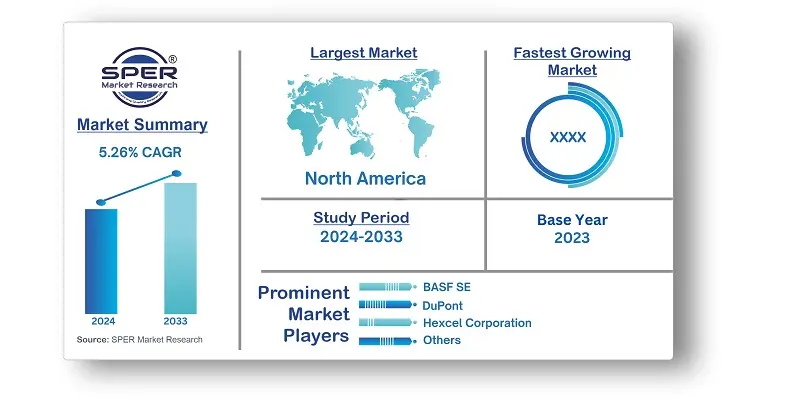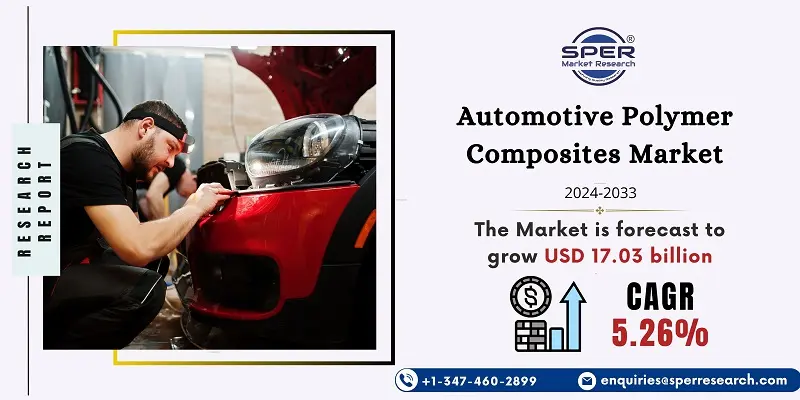
Automotive Polymer Composites Market Trends, Share, Size, Demand, Revenue and Future Outlook
Automotive Polymer Composites Market Growth, Size, Trends Analysis- By Resin Type, By Vehicle Type- Regional Outlook, Competitive Strategies and Segment Forecast to 2033
| Published: Nov-2024 | Report ID: CHEM24108 | Pages: 1 - 245 | Formats*: |
| Category : Chemical & Materials | |||
- February 2023; One of the top manufacturers of thermoplastics and resins for battery and construction safety applications, Pyrophobic Systems Ltd., revealed that General Motors, a major OEM, has chosen to use their LithiumPrevent 200 material in batteries.
- April 2022; A 60% stake in Fiberline Composites AS, a producer of glass fiber and pultruded carbon materials used in the creation of wind blades, was revealed by Gurit Holdings AG.


| Report Metric | Details |
| Market size available for years | 2020-2033 |
| Base year considered | 2023 |
| Forecast period | 2024-2033 |
| Segments covered | By Resin Type, By Vehicle Type |
| Regions covered | North America, Asia-Pacific, Latin America, Middle East & Africa, and Europe. |
| Companies Covered | BASF SE, Covestro AG, DuPont, Gurit Services AG, Hexcel Corporation, Johns Manville, Kolon Industries, Mitsubishi Chemical Corporation, Owens Corning, Plasan Sasa Ltd, Pyrophobic Systems Ltd. |
- Automotive manufacturers
- Polymer composite producers
- Suppliers of raw materials (resins, fibers)
- Electric vehicle (EV) manufacturers
- Automotive component suppliers
- Research and development institutions
- Government regulatory bodies
- Environmental and sustainability organizations
- Automotive design and engineering firms
- Transportation and logistics companies
| By Resin Type: | |
| By Vehicle Type: |
- Global Automotive Polymer Composites Market Size (FY’2024-FY’2033)
- Overview of Global Automotive Polymer Composites Market
- Segmentation of Global Automotive Polymer Composites Market By Resin Type (Polypropylene, Polyurethanes, Nylon, Polyvinyl Chloride, Abs, Polyethylenes, Polycarbonate, and Other Resins)
- Segmentation of Global Automotive Polymer Composites Market By Vehicle Type (Passenger Cars, Light Commercial Vehicles, and Trucks and Buses)
- Statistical Snap of Global Automotive Polymer Composites Market
- Expansion Analysis of Global Automotive Polymer Composites Market
- Problems and Obstacles in Global Automotive Polymer Composites Market
- Competitive Landscape in the Global Automotive Polymer Composites Market
- Impact of COVID-19 and Demonetization on Global Automotive Polymer Composites Market
- Details on Current Investment in Global Automotive Polymer Composites Market
- Competitive Analysis of Global Automotive Polymer Composites Market
- Prominent Players in the Global Automotive Polymer Composites Market
- SWOT Analysis of Global Automotive Polymer Composites Market
- Global Automotive Polymer Composites Market Future Outlook and Projections (FY’2024-FY’2033)
- Recommendations from Analyst
1.1. Scope of the report1.2. Market segment analysis
2.1. Research data source
2.1.1. Secondary Data2.1.2. Primary Data2.1.3. SPER’s internal database2.1.4. Premium insight from KOL’s
2.2. Market size estimation
2.2.1. Top-down and Bottom-up approach
2.3. Data triangulation
4.1. Driver, Restraint, Opportunity and Challenges analysis
4.1.1. Drivers4.1.2. Restraints4.1.3. Opportunities4.1.4. Challenges
4.2. COVID-19 Impacts of the Global Automotive Polymer Composites Market
5.1. SWOT Analysis
5.1.1. Strengths5.1.2. Weaknesses5.1.3. Opportunities5.1.4. Threats
5.2. PESTEL Analysis
5.2.1. Political Landscape5.2.2. Economic Landscape5.2.3. Social Landscape5.2.4. Technological Landscape5.2.5. Environmental Landscape5.2.6. Legal Landscape
5.3. PORTER’s Five Forces
5.3.1. Bargaining power of suppliers5.3.2. Bargaining power of buyers5.3.3. Threat of Substitute5.3.4. Threat of new entrant5.3.5. Competitive rivalry
5.4. Heat Map Analysis
6.1. Global Automotive Polymer Composites Market Manufacturing Base Distribution, Sales Area, Product Type6.2. Mergers & Acquisitions, Partnerships, Product Launch, and Collaboration in Global Automotive Polymer Composites Market
7.1. Global Automotive Polymer Composites Market Size, Share and Forecast, By Resin Type, 2020-20267.2. Global Automotive Polymer Composites Market Size, Share and Forecast, By Resin Type, 2027-20337.3. Polypropylene7.4. Polyurethanes7.5. Nylon7.6. Polyvinyl Chloride7.7. Abs7.8. Polyethylenes7.9. Polycarbonate
8.1. Global Automotive Polymer Composites Market Size, Share and Forecast, By Vehicle Type, 2020-20268.2. Global Automotive Polymer Composites Market Size, Share and Forecast, By Vehicle Type, 2027-20338.3. Passenger Cars8.4. Light Commercial Vehicles8.5. Trucks8.6. Buses
9.1. Global Automotive Polymer Composites Market Size and Market Share
10.1. Global Automotive Polymer Composites Market Size and Market Share By Region (2020-2026)10.2. Global Automotive Polymer Composites Market Size and Market Share By Region (2027-2033)10.3. Asia-Pacific
10.3.1. Australia10.3.2. China10.3.3. India10.3.4. Japan10.3.5. South Korea10.3.6. Rest of Asia-Pacific
10.4. Europe
10.4.1. France10.4.2. Germany10.4.3. Italy10.4.4. Spain10.4.5. United Kingdom10.4.6. Rest of Europe
10.5. Middle East and Africa
10.5.1. Kingdom of Saudi Arabia10.5.2. United Arab Emirates10.5.3. Qatar10.5.4. South Africa10.5.5. Egypt10.5.6. Morocco10.5.7. Nigeria10.5.8. Rest of Middle-East and Africa
10.6. North America
10.6.1. Canada10.6.2. Mexico10.6.3. United States
10.7. Latin America
10.7.1. Argentina10.7.2. Brazil10.7.3. Rest of Latin America
11.1. BASF SE
11.1.1. Company details11.1.2. Financial outlook11.1.3. Product summary11.1.4. Recent developments
11.2. Covestro AG
11.2.1. Company details11.2.2. Financial outlook11.2.3. Product summary11.2.4. Recent developments
11.3. DuPont
11.3.1. Company details11.3.2. Financial outlook11.3.3. Product summary11.3.4. Recent developments
11.4. Gurit Services AG
11.4.1. Company details11.4.2. Financial outlook11.4.3. Product summary11.4.4. Recent developments
11.5. Hexcel Corporation
11.5.1. Company details11.5.2. Financial outlook11.5.3. Product summary11.5.4. Recent developments
11.6. Johns Manville
11.6.1. Company details11.6.2. Financial outlook11.6.3. Product summary11.6.4. Recent developments
11.7. Johns Manville
11.7.1. Company details11.7.2. Financial outlook11.7.3. Product summary11.7.4. Recent developments
11.8. Kolon Industries
11.8.1. Company details11.8.2. Financial outlook11.8.3. Product summary11.8.4. Recent developments
11.9. Mitsubishi Chemical Corporation
11.9.1. Company details11.9.2. Financial outlook11.9.3. Product summary11.9.4. Recent developments
11.10. Owens Corning
11.10.1. Company details11.10.2. Financial outlook11.10.3. Product summary11.10.4. Recent developments
11.11. Others
SPER Market Research’s methodology uses great emphasis on primary research to ensure that the market intelligence insights are up to date, reliable and accurate. Primary interviews are done with players involved in each phase of a supply chain to analyze the market forecasting. The secondary research method is used to help you fully understand how the future markets and the spending patterns look likes.
The report is based on in-depth qualitative and quantitative analysis of the Product Market. The quantitative analysis involves the application of various projection and sampling techniques. The qualitative analysis involves primary interviews, surveys, and vendor briefings. The data gathered as a result of these processes are validated through experts opinion. Our research methodology entails an ideal mixture of primary and secondary initiatives.



Frequently Asked Questions About This Report
PLACE AN ORDER
Year End Discount
Sample Report
Pre-Purchase Inquiry
NEED CUSTOMIZATION?
Request CustomizationCALL OR EMAIL US
100% Secure Payment






Related Reports
Our Global Clients
Our data-driven insights have influenced the strategy of 200+ reputed companies across the globe.






















